Rupert Matthews's Blog, page 10
May 9, 2020
BOOK REVIEW - The Franks by Edward James

This is a good introduction to the subject of the Franks. It covers their history, society, government, religion and other issues from the time that they first emerge into history in the 2nd century AD through to the fall of the Merovingian Dynasty, by which time the Franks had become largely assimilated into the Romano-Gauls who they had conquered.
The book is packed with facts about the Franks and their times. I wouldn't have wanted more facts or a longer book, as an introduction to the subject. The book is well written, the author avoids jargon and explains what he is talking about when looking at details of archaeological digs or other technical stuff. He is to be applauded for this.
I will admit that I did struggle a bit with confused with the names of kings, queens, princes, nobles and others as they came and went with great rapidity. I suppose this is partly a function of the shortness of the text. However, I do feel that the author could have made more effort to differentiate between the figures and remind the reader who is being discussed. The situation was not made any clearer by the fact that so many of the names are very similar. No sooner have we learned who Childeric was than we move on the Chilperic and Chlothair is easily confused with Clothar - at least I found it so.
My main complaint, however, is that the author fails to draw much in the way of conclusions. And in many places positively shies away from doing so. He discusses a grave packed with valuable items, but then definitively states that just because it is the richest grave for miles does not mean the chap buried there was rich. He even says that we cannot be certain of the name of a buried woman when she is found with a ring with her name engraved on it. Time and again the author presents facts about archaeological digs, manuscripts or coins but refused to tell the reader what the facts might mean. I found this very frustrating.
On the whole, a reasonable attempt to explain the Franks in a relatively short book. But I came away knowing a lot of individual facts, but having only a hazy idea of the big picture.

Published on May 09, 2020 03:15
May 7, 2020
Doctor's Orders - 1500 years of misery
While looking into the taxation policies of the Merovingian kings of early medieval France I fell upon a little anecdote that really set me thinking about the coronavirus that we are currently experiencing and how society is dealing with it.
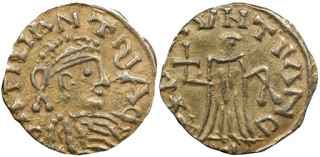 A gold coin of King Guntram
A gold coin of King Guntram
Let's start by looking at the incident from the year 588 that I came across. It concerns King Guntram, who ruled the Kingdom of Orléans, a part of the Frankish realm, from AD 561 to AD 592. Due to the murderous family feuding of the Merovingian Dynasty, Guntram was ruling Marseilles by 588. The city and port was enormously important at the time, mainly because customs and tariffs were a major source of royal income. Whoever ruled a major port would automatically be a very wealthy ruler indeed.
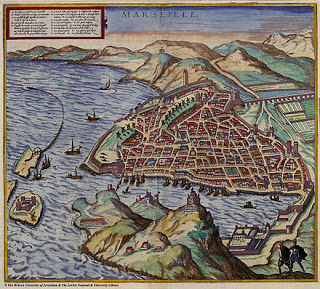 A view of medieval Marseilles
A view of medieval Marseilles
In the year 588 a terrible disease broke out in Marseilles, killing thousands, halting trade and disrupting the smooth flow of taxes to King Guntram. From the symptoms of the disease as described by a near contemporary chronicler, Bishop Gregory of Tours, the disease was almost certainly bubonic plague. This disease - known to historians as the Plague of Justinian - hit the great city of Constantinople in the year 541, having apparently arrived from Egypt. Within a few years the plague had spread first around the Mediterranean and then across Europe. The death toll in most areas is unknown, but in Constantinople was around 40% of the population. The plague came back every few years for several generations - the outbreak in Marseilles in 588 being one such revisitation.
 The painful swellings typical of bubonic plague
The painful swellings typical of bubonic plague
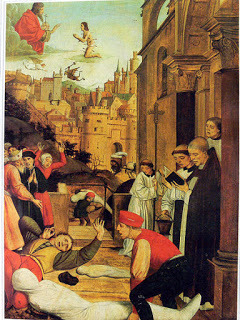 The Plague of Justinian hits Constantinople, from a later image Faced with a deadly plague killing a large proportion of the population and their economy being devastated, the people of Marseilles appealed to their government for help. Gregory of Tours describes what happened next:
The Plague of Justinian hits Constantinople, from a later image Faced with a deadly plague killing a large proportion of the population and their economy being devastated, the people of Marseilles appealed to their government for help. Gregory of Tours describes what happened next:
"King Guntram was well known for his charity, and much given to vigils and fasting. Like some good bishop providing remedies by which the wounds of a common sinner might be healed, King Guntram ordered the entire people to assemble in church and to celebrate the service of Rogations with great devotion. He then commanded that everyone should eat and drink nothing but barley bread and pure water, and that all should be regular in keeping the religious vigils. His orders were obeyed, and he seemed so anxious about all his people that he might well have been taken for one of Our Lord's Bishops, rather than for a king."
In due course the plague ceased to kill people in Marseilles, and everyone was duly grateful to both King Guntram and to God.
What struck me about this episode were the parallels with the corona virus today. A disease has struck the UK. Thankfully the death rate - something under 1% is nothing like as terrible as the 40% that bubonic plague could manage, but is nonetheless shocking to a modern society unaccustomed to fatal epidemics. The people turn to the government. The government in turn takes the best advice that it can find, and imposes on the people measures that it believes will bring relief from the disease.
In the case of King Guntram in 588, this took the form of frequent attendance at church services, plus a strict dietry regime of barley bread and water. For the UK government in 2020 it takes the form of social isolation and effective house arrest. Neither method actually cures the disease, nor lessens its effects on those that catch it. Guntram hoped that by displaying holiness and doing penance, the people would persuade God to remove the plague. The modern plan is to "flatten the curve" so that at no point is the NHS overwhelmed. But unless a cure or vaccine is found, coronavirus will infect something approaching 80% of the population before herd immunity is achieved. All the social isolation is doing is delaying the spread of the disease so that fewer people have it at any one time.
The second thing that struck me was that both "solutions" to an incurable epidemic disease involved a fair degree of hardship for the hapless popultion. The good folk of Marseilles had to spend long hours in churches taking part in rituals. The good people of the UK have to spend pretty much all their time cooped up indoors, emerging on to their doorsteps on Thursday evenings to clap the NHS. Admittedly the UK government in 2020 has not yet gone so far as to impose a bread and water diet on their population - though the European Union has decreed [with no evidence at all] that drinking alcohol when suffering from coronavirus is very dangerous. The default instinct of those in authority, it seems, is to respond by imposing even more misery on those already suffering.
When, I wonder, will governments and doctors decree that the best course of action when tackling a disease is to go down the pub with your mates, or tuck into a massive helping of steak and chips?
You can find out more about King Guntram HERE
You can find out more about the Plague of Justinian HERE
You can find out more about Marseilles HERE
You can find out more about bubonic plague HERE
You can find out more about Gregory of Tours HERE

 A gold coin of King Guntram
A gold coin of King GuntramLet's start by looking at the incident from the year 588 that I came across. It concerns King Guntram, who ruled the Kingdom of Orléans, a part of the Frankish realm, from AD 561 to AD 592. Due to the murderous family feuding of the Merovingian Dynasty, Guntram was ruling Marseilles by 588. The city and port was enormously important at the time, mainly because customs and tariffs were a major source of royal income. Whoever ruled a major port would automatically be a very wealthy ruler indeed.
 A view of medieval Marseilles
A view of medieval MarseillesIn the year 588 a terrible disease broke out in Marseilles, killing thousands, halting trade and disrupting the smooth flow of taxes to King Guntram. From the symptoms of the disease as described by a near contemporary chronicler, Bishop Gregory of Tours, the disease was almost certainly bubonic plague. This disease - known to historians as the Plague of Justinian - hit the great city of Constantinople in the year 541, having apparently arrived from Egypt. Within a few years the plague had spread first around the Mediterranean and then across Europe. The death toll in most areas is unknown, but in Constantinople was around 40% of the population. The plague came back every few years for several generations - the outbreak in Marseilles in 588 being one such revisitation.
 The painful swellings typical of bubonic plague
The painful swellings typical of bubonic plague
 The Plague of Justinian hits Constantinople, from a later image Faced with a deadly plague killing a large proportion of the population and their economy being devastated, the people of Marseilles appealed to their government for help. Gregory of Tours describes what happened next:
The Plague of Justinian hits Constantinople, from a later image Faced with a deadly plague killing a large proportion of the population and their economy being devastated, the people of Marseilles appealed to their government for help. Gregory of Tours describes what happened next:"King Guntram was well known for his charity, and much given to vigils and fasting. Like some good bishop providing remedies by which the wounds of a common sinner might be healed, King Guntram ordered the entire people to assemble in church and to celebrate the service of Rogations with great devotion. He then commanded that everyone should eat and drink nothing but barley bread and pure water, and that all should be regular in keeping the religious vigils. His orders were obeyed, and he seemed so anxious about all his people that he might well have been taken for one of Our Lord's Bishops, rather than for a king."
In due course the plague ceased to kill people in Marseilles, and everyone was duly grateful to both King Guntram and to God.
What struck me about this episode were the parallels with the corona virus today. A disease has struck the UK. Thankfully the death rate - something under 1% is nothing like as terrible as the 40% that bubonic plague could manage, but is nonetheless shocking to a modern society unaccustomed to fatal epidemics. The people turn to the government. The government in turn takes the best advice that it can find, and imposes on the people measures that it believes will bring relief from the disease.
In the case of King Guntram in 588, this took the form of frequent attendance at church services, plus a strict dietry regime of barley bread and water. For the UK government in 2020 it takes the form of social isolation and effective house arrest. Neither method actually cures the disease, nor lessens its effects on those that catch it. Guntram hoped that by displaying holiness and doing penance, the people would persuade God to remove the plague. The modern plan is to "flatten the curve" so that at no point is the NHS overwhelmed. But unless a cure or vaccine is found, coronavirus will infect something approaching 80% of the population before herd immunity is achieved. All the social isolation is doing is delaying the spread of the disease so that fewer people have it at any one time.
The second thing that struck me was that both "solutions" to an incurable epidemic disease involved a fair degree of hardship for the hapless popultion. The good folk of Marseilles had to spend long hours in churches taking part in rituals. The good people of the UK have to spend pretty much all their time cooped up indoors, emerging on to their doorsteps on Thursday evenings to clap the NHS. Admittedly the UK government in 2020 has not yet gone so far as to impose a bread and water diet on their population - though the European Union has decreed [with no evidence at all] that drinking alcohol when suffering from coronavirus is very dangerous. The default instinct of those in authority, it seems, is to respond by imposing even more misery on those already suffering.
When, I wonder, will governments and doctors decree that the best course of action when tackling a disease is to go down the pub with your mates, or tuck into a massive helping of steak and chips?
You can find out more about King Guntram HERE
You can find out more about the Plague of Justinian HERE
You can find out more about Marseilles HERE
You can find out more about bubonic plague HERE
You can find out more about Gregory of Tours HERE

Published on May 07, 2020 10:18
May 6, 2020
RAF No.105 Squadron - a postcard from 1940
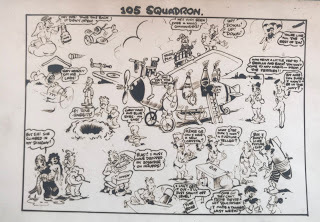
During the 2020 pandemic lockdown I took advantage of the enforced idleness to rummage through a load of old boxes in the attic. In one I found this old postcard. It dates to 1940 and is a part of my family history. If you click on the image you will see an enlarged view so that you can read the jokes.
It is a cartoon drawn by my father in the summer of 1940 when he was serving with No.105 Squadron of the RAF. As you can see, my dad was a talented cartoonist. After the war he went to work for the Amalgamated Press and drew for some of the great children's comics of the time. He was always looking for a way to turn an honest bob and when on the squadron he earned some extra cash by drawing cartoons of the officers and men for them to send back home to their families. He also did several humorous cartoons that he then had printed so that he could sell lots of copies. This is one of those. Actually, the family did not have a copy of this one and we did not know it even existed until I saw it on Ebay one day and bought it.
The cartoon is packed with loads of gags, some funnier than others. Knowing my dad I would imagine that all the squadron men shown are portraits of actual men then with the squadron. The figure with the bomb in his lunch box looks like my father as he was back then.
This card can be dated quite precisely. Father volunteered the day after war was declared, 4 September 1939 but there were so many volunteers that he did not actually go off to start his training for some time. Having completed his training he was posted to No.105 Squadron, then part of the BEF in northern France. The squadron was equipped with Fairey Battle light bombers. This was a single-engined bomber that was designed for low level attacks in close co-operation with the army. You can read more about the Fairey Battle HERE.
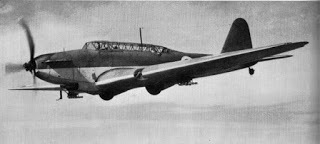
As fate would decide, he never got there. He was still waiting for transport when the German Blitzkrieg began in May 1940. The squadron suffered heavy losses in the desperate fighting that led to the retreat to Dunkirk and with everything going on, my father never found transport to get him out to France - everyone was coming the other way.
As a result he did not joined No.105 Squadron until late in June 1940, when they were at RAF Honington. There the squadron was getting new aircrew to replace all those killed in France, plus a full complement of other personnel and equipment to replace losses. In August the squadron was re-equipped with Bristol Blenheims, a twin-engined medium bomber. You can read more about the Bristol Blenheim HERE.
This cartoon shows a single-engined bomber, so it cannot be a Blenheim. There is also a dinghy slung underneath the fuselage [the real one, of course, was inflatable and kept inside the bomber]. And one of the pilots has picked up a rather voluptuous mermaid. Undoubtedly this means that the squadron was flying operations over the sea at the time. So this must date to July 1940.
The squadron had a battle axe as its badge. My father always referred to the squadron as "Battle Axe Blenheims". One day in the 1990s he took me to St Clement Danes Church in London. This is the RAF Church and has a fine statue of Bomber Harris outside. My dad always admired Harris. he took me inside and pointed out to me a carving of the No.105 Battle Axe badge in the church. You can read more about No.105 Squadron HERE, more about St Clement Danes HERE and more about Bomber Harris HERE
 So that is the story of this cartoon postcard from 1940. Enjoy!
So that is the story of this cartoon postcard from 1940. Enjoy!
Published on May 06, 2020 08:28
April 29, 2020
The battle of the Aisne 1914

After being defeated on the Marne, German commander in chief Helmuth von Moltke ordered his armies to retreat to the River Aisne.
When they reached the Aisne, the Germans took up position on the hills north of the river. From there they could shoot accurately at any troops trying to cross the river.
British and French pilots flying to scout the German positions found they were often being shot at by soldiers of their own armies. They began painting red, white and blue stripes on the wings of their aircraft so that they could be recognised.
A few weeks later the High Command ordered the pilots to paint standard markings on their aircraft. British planes had a red circle inside a white circle inside a blue circle. French aircraft sported the same circles in reverse.
The German pilots, meanwhile, began painting a black cross on their aircraft.
On 13 September the British together with the French 5th and 6th Armies crossed the Aisne on pontoon bridges under heavy fire and attacked the Germans. They broke the German lines and moved forward.
The following day the British and French found themselves faced by German troops in trenches and machine gun nests. Unable to advance against heavy fire, nor to inflict casualties on the Germans, the allies halted and dug their own trenches.
Joffre ordered a new attack on 18 September, but his men failed to make any advance and suffered heavy casualties. Joffre called off the attack and ordered his artillery to begin shelling the German trenches.
The Battle of the Aisne marked the beginning of trench warfare on the Western Front.
Kaiser Wilhelm II of Germany sacked von Moltke as commander in chief and replaced him with Erich von Falkenhayn.

Published on April 29, 2020 04:05
The Army takes power in Ancient Rome
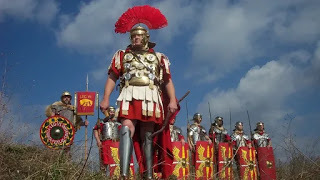
After the murder of the Emperor Commodus in 193, the Senate voted to make the famously well-educated retired soldier Publius Helvius Pertinax the new emperor. Pertinax agreed and was installed in power.
When Pertinax tried to reduce the excessive wages and bonuses paid to the army, he was murdered by the Praetorian Guard. The Praetorians then appointed Marcus Didius Julianus to be emperor.
Julianus lavished gifts on the Praetorians, which alienated the fighting legions stationed on the frontiers. The 16 legions of the Rhine-Danube frontier appointed the general Lucius Septimius Severus to be emperor.
Septimius Severus marched an army to Rome. As the troops approached, the Senate declared that Julianus was deposed and that Severus was the new emperor. They sent a small group of men to kill Julianus.
Although the official start of the rule of Septimius Severus came with the vote in the Senate that gave him the powers and wealth of an emperor, it was clear that the Senate had passed the motion only because of the approaching army.
The commander Maximinus Thrax was proclaimed emperor by the army in 235, but he waited until the Senate had passed a motion acclaiming him before assuming the title. However, when a group of senators objected, Maximinius had them executed without trial.
In 238 the Senate once again tried to assert itself. The Senate appointed two highly respected senators, Decius Balbinus and Marcus Pupienus, to be joint emperors. But these men lacked support outside the Senate and were murdered by the Praetorians.
The army rallied around Gordian III, who came to Rome to accept a vote of the Senate that made him emperor. After this, the Senate never again tried to appoint an emperor. They always waited to see who the army supported first.
The army rarely supported an emperor for long. If a ruler did not win military victories quickly, or failed to give the soldiers a share of the wealth of the emperor, he was quickly murdered and a new commander appointed in his place.
Even the successful emperors such as Diocletian (see page 38) and Constantine (see page 40) managed to stay in power only because they kept the soldiers content.

Published on April 29, 2020 04:02
A 17th Century musketeer
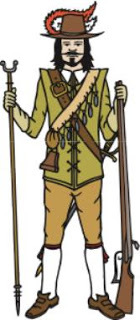
A musketeer from the time of the Civil War. His main weapon is a matchlock musket. This gun fired a lead bullet weighing about half an ounce. Due to the loose fit of the ball in the barrel the weapon was accurate to only around 80 yards, though the ball could kill a man at anything up to 150 yards. The forked prop in his right hand is a support to take the weight of the weapon when it was fired, these supports were going out of fashion at this date as the guns became lighter. Dangling from his cross belt are a number of pre-packed cartridges containing gunpowder and musket ball. Further ammunition would be kept in a box or chest nearby to be shared out to the men as needed. Rates of fire were slow, around one shot per minute. He therefore has a sword as a secondary weapon to use in hand to hand fighting.

Published on April 29, 2020 03:59
Ancient Egyptian Farmers
 Every year the river Nile flooded. The flood waters spread fertile silt over the fields and deluged them with water. The water was trapped behind dams and in deep pits so that it could be used to water the crops in the dry months that followed. If the floods were not high enough the crops might not grow properly. Nilometers were gauges that measured how much the river rose at flood time.
Every year the river Nile flooded. The flood waters spread fertile silt over the fields and deluged them with water. The water was trapped behind dams and in deep pits so that it could be used to water the crops in the dry months that followed. If the floods were not high enough the crops might not grow properly. Nilometers were gauges that measured how much the river rose at flood time. Field boundaries
Each farmer and landowner had their own fields to farm, but canals that carried water from the Nile were shared between various people. There were many disputes between farmers about how much water they could use and who was responsible for keeping the canals in good condition.
The Shaduf
Water was lifted out of the canal to be poured on to fields by means of the shaduf. This is still used in Egypt today. It consists of a bucket attached to a long pole which has a heavy weight at one end. The farmer fills the bucket with water. Then he swivels the pole around, balancing the weight of the water with the counterweight. Egyptian Crops
The most important crops grown in ancient Egypt were grain such as wheat and barley. Other crops included grapes, onions, garlic, cucumbers, leeks, cabbages and melons. Cattle, sheep and pigs were also kept for meat or milk.
Hunters
The Egyptians enjoyed eating meat from wild animals. Birds were hunted by throwing sticks or stones at them, while men with spears hunted hippopotamus in the Nile. Antelopes, gazelles and hares were hunted in the desert areas.
Egyptian Houses
Egyptian houses were built out of bricks made by drying mud in the sun. They had flat roofs and small windows. Most families had only a room or two in their house, but noblemen had much larger houses with a small shrine attached and storerooms for keeping food and drink.
Quiz Question
What did a nilometer measure?
Activity
Make a Menu
You could design an Egyptian menu for your family dinner.
You will need:
A sheet of paper
Coloured crayons or pencils
Find out what you are going to have for dinner. Now write out the list of foods and decorate it with pictures drawn in the Egyptian style, as seen in this book.

Published on April 29, 2020 03:57
Ancient Greek Building Techniques
Most Greek stone buildings were constructed using stone dug out of local quarries, but some were faced with more expensive stone such as marble that was hardwearing and looked better.
Stones were cut roughly to the right size and shape at the quarry. They were then moved by boat or by cart to the building site.
Once at the building site, each stone would be carefully carved using bronze or iron tools to precisely the correct shape before being lifted into place.
Stone blocks had small holes in the top where metal hooks could be fitted. The hooks were linked to ropes that ran through pulleys. Teams of slaves hauled on the ropes to lift the stones.
The stone blocks were held in place by bronze hooks and strips, known as cramps. These could be hidden inside the stone so that they could not be seen once the building was finished.
Columns were built up out of a number of circular sections called drums. Each drum had a hole at its centre through which a wooden pole was pushed. Each drum was put into position by being lowered over the top of the pole.
Columns were often built with a bulge at the middle. When seen from a distance a straight column can look thinner at the middle, so making it bulge actually made it look straight.
The statues and sculptures that adorned Greek buildings were carved in a workshop on the building site. Once finished they were lifted into position.
When the main building work was completed, painters went to work. Most of the sculptures and other decorative features were painted in bright shades of red, blue and may even have been gilded.
Architects liked to keep their methods of building a secret so that they alone knew how to build. When he was asked how he had erected the gigantic gate of the Temple of Artemis (see page 152) the architect Chersiphron said “Artemis did it”.

Stones were cut roughly to the right size and shape at the quarry. They were then moved by boat or by cart to the building site.
Once at the building site, each stone would be carefully carved using bronze or iron tools to precisely the correct shape before being lifted into place.
Stone blocks had small holes in the top where metal hooks could be fitted. The hooks were linked to ropes that ran through pulleys. Teams of slaves hauled on the ropes to lift the stones.
The stone blocks were held in place by bronze hooks and strips, known as cramps. These could be hidden inside the stone so that they could not be seen once the building was finished.
Columns were built up out of a number of circular sections called drums. Each drum had a hole at its centre through which a wooden pole was pushed. Each drum was put into position by being lowered over the top of the pole.
Columns were often built with a bulge at the middle. When seen from a distance a straight column can look thinner at the middle, so making it bulge actually made it look straight.
The statues and sculptures that adorned Greek buildings were carved in a workshop on the building site. Once finished they were lifted into position.
When the main building work was completed, painters went to work. Most of the sculptures and other decorative features were painted in bright shades of red, blue and may even have been gilded.
Architects liked to keep their methods of building a secret so that they alone knew how to build. When he was asked how he had erected the gigantic gate of the Temple of Artemis (see page 152) the architect Chersiphron said “Artemis did it”.

Published on April 29, 2020 03:53
Duke of Marlborough and Battle of Blenheim
 Duke of Marlborough and Battle of BlenheimThe great Battle of Blenheim showed that the tide of history can be stopped and changed by a single event. Although the quarrels and disputes which led to it are long forgotten they might not have been forgotten if the battle had gone the other way.In 1700 King Charles II of Spain died without leaving an heir. the various kings and rulers of Europe had for years been debating what should happen to Spain and her massive empire when Charles died. It had been generally agreed that the Spanish Empire was too powerful for any one person to control, so it was decided to divide up the Empire among other statesHowever, when Charles died he left his entire dominions to Philip, Duke of Anjou and grandson of King Louis XIV of France. Philip and Louis at once accepted the offer, ignored their agreements with other monarchs, and moved into Spain to take over. Louis was already a powerful monarch, so if his family had gained possession of the mighty Spanish Empire also, they would have become by far the mightiest power in the world. No other state would have been able to stand up to them and they could have done as they liked with the world.Other monarchs realised they had to act quickly, before Philip could gain control of the Spanish Empire. A Grand Alliance was formed between Britain, the Netherlands, the Austrian Hapsburgs, Portugal and various German and Italian states. War was declared in 1701 and Europe plunged into bloodshed.The early months of war were indecisive with the great armies besieging towns and fruitlessly trying to outmanoeuvre each other. Then, in 1704, the French gathered their armies for an attack on Vienna, capital of the Hapsburgs. If the attack were successful the Austrians would drop out of the Grand Alliance and France would gain victory.The British commander, the Duke of Marlborough, saw the danger. He gathered his army away from the various sieges and skirmishes in the Netherlands and raced across Germany towards Vienna. He reached the city before the French, joined forces with the Austrian Eugene of Savoy and set out to face the French, commanded by Marshal Tallard.The two armies were about equal in size, some 55,000 men, but the French enjoyed a superior position. Tallard drew up his men on a four kilometre long ridge with a marshy stream, the Nebel, running along the foot of the slope. The right flank was protected by the Danube river and the left flank by hills. Three villages stood on the he crest of the ridge, Blenheim on the right, Oberglau in the centre and Lutzingen on the left. Tallard fortified the villages and filled them with powerful forces of infantry. The spaces in between were held by cavalry, artillery and small forces of infantry. It was a very strong position and Tallard expected the Allies to fall back, hoping to lure the French on to other ground.Marlborough and Eugene had other ideas. They arrived in front of the French lines at dawn, struggled across the marshy stream and began an attack just after noon. While Eugene held back attempts by the French left wing to outflank the Allies, Marlborough pretended to assault the fortified villages. In fact, he was using only the minority of his forces so that the French defenders were kept pinned down.
Duke of Marlborough and Battle of BlenheimThe great Battle of Blenheim showed that the tide of history can be stopped and changed by a single event. Although the quarrels and disputes which led to it are long forgotten they might not have been forgotten if the battle had gone the other way.In 1700 King Charles II of Spain died without leaving an heir. the various kings and rulers of Europe had for years been debating what should happen to Spain and her massive empire when Charles died. It had been generally agreed that the Spanish Empire was too powerful for any one person to control, so it was decided to divide up the Empire among other statesHowever, when Charles died he left his entire dominions to Philip, Duke of Anjou and grandson of King Louis XIV of France. Philip and Louis at once accepted the offer, ignored their agreements with other monarchs, and moved into Spain to take over. Louis was already a powerful monarch, so if his family had gained possession of the mighty Spanish Empire also, they would have become by far the mightiest power in the world. No other state would have been able to stand up to them and they could have done as they liked with the world.Other monarchs realised they had to act quickly, before Philip could gain control of the Spanish Empire. A Grand Alliance was formed between Britain, the Netherlands, the Austrian Hapsburgs, Portugal and various German and Italian states. War was declared in 1701 and Europe plunged into bloodshed.The early months of war were indecisive with the great armies besieging towns and fruitlessly trying to outmanoeuvre each other. Then, in 1704, the French gathered their armies for an attack on Vienna, capital of the Hapsburgs. If the attack were successful the Austrians would drop out of the Grand Alliance and France would gain victory.The British commander, the Duke of Marlborough, saw the danger. He gathered his army away from the various sieges and skirmishes in the Netherlands and raced across Germany towards Vienna. He reached the city before the French, joined forces with the Austrian Eugene of Savoy and set out to face the French, commanded by Marshal Tallard.The two armies were about equal in size, some 55,000 men, but the French enjoyed a superior position. Tallard drew up his men on a four kilometre long ridge with a marshy stream, the Nebel, running along the foot of the slope. The right flank was protected by the Danube river and the left flank by hills. Three villages stood on the he crest of the ridge, Blenheim on the right, Oberglau in the centre and Lutzingen on the left. Tallard fortified the villages and filled them with powerful forces of infantry. The spaces in between were held by cavalry, artillery and small forces of infantry. It was a very strong position and Tallard expected the Allies to fall back, hoping to lure the French on to other ground.Marlborough and Eugene had other ideas. They arrived in front of the French lines at dawn, struggled across the marshy stream and began an attack just after noon. While Eugene held back attempts by the French left wing to outflank the Allies, Marlborough pretended to assault the fortified villages. In fact, he was using only the minority of his forces so that the French defenders were kept pinned down. As soon as the main French forces were bottled up in the villages, Marlborough unleashed a massed attack of 23 infantry battalions and 90 cavalry squadrons, supported by artillery. The attacks swept through the French centre, driving away all defenders in the open country. The move isolated the French infantry in Blenheim and Oberglau, just as Eugene was driving the French back around Lutzingen. By late afternoon the French garrisons realised that their position was helpless and surrendered. Of the 55,000 French troops, only 15,000 escaped death or captured.
At Blenheim the main French field army was crushed. Although the war dragged on for another nine years, the French never again came close to outright victory. The British captured Gibraltar in 1704 and within two years they and the Portuguese had captured several major cities. The only point in further fighting was to secure territory and towns which would be useful in the peace negotiations.
In 1713 the Treaty of Utrecht was signed, bringing the war to an end. Philip of Anjou became King of Spain, but his Empire was stripped of various territories. In this way the French king was denied his dream of becoming the most powerful monarch on Earth.

Published on April 29, 2020 03:51
A Bum Freezer from the Attic
During the Corona Virus lockdown, I did various jobs about the house. One was to sort out the attic. I found an old box that I had forgotten about entirely. It contained old clothes that had belonged to my father, but which were too small for me to fit into. They were too worn for sending to a charity shop, and I could never bring myself to throw them away as they were all top quality gear. So they went into the attic. I'll be posting about some of these as we go along.
The first to write about was what my father always referred to as his Bum Freezer Suit. Here it is, together with the tie that was wrapped around the hanger on which it had been when put away.

As you can see it is a two piece suit with a two button front and quite a deep V open front and medium width lapels. Standard collar and lapels for a single breasted suit like this. At first sight it looks charcoal grey, but when we look at the fabric we will see that is not quite right.
So, what is a "bum freezer suit". As the name implies, it was a suit with a very short jacket. Th polite term for this was a "Roman Jacket" as the style first came to prominence in Italy and the Roman fashion houses. Foreign films were shown more often in mainstream cinemas back in the 1950s and 1960s, so continental influences were more a part of the popular scene than they are now. Short jackets enjoyed a good run of fashion. When the Beatles first hit the big time, they wore short jacket suits.
Anyway, back to my father's suit from the attic. Here is the label inside the inner breast pocket. You can see that it was mde by H. Huntsman in August 1958. My father got his work suits from Huntsman. He said that they made the best jackets in the world.

Founded in 1849, Huntsman is a Savile Row tailor, producing traditional bespoke suits and other items for gentlemen and ladies. Huntsman has been granted several royal warrants bestowed by British and European monarchs, including The Prince of Wales, (later Edward VII) and Queen Victoria. Huntsman is also one of the founders of the trade body responsible for protecting and promoting the working practices of Savile Row.
Here is the inside of the jacket. The arms have a cream satin lining, allowing the arms to slide easily into what seem to me to be rather slim sleeves. The lining of the body of the jacket, in contrast, is rough and thick. There is a lot of friction there. You can see the trousers in this picture. They are "drainpipes" - they are slim and taper to the ankles quite sharply.
 The next photo shows the two button fastening. As you can see the front of the jacket slopes quite sharply back from the upper button. I remember that my father used to wear this suit with only the top button done up. The lower button was never fastened. Looking at this, I suspect that it was not supposed to do up at all.
The next photo shows the two button fastening. As you can see the front of the jacket slopes quite sharply back from the upper button. I remember that my father used to wear this suit with only the top button done up. The lower button was never fastened. Looking at this, I suspect that it was not supposed to do up at all.
 This photo of the pocket flap shows that they flap is horizontal, a fairly formal look for a business suit. You can see that up close the fabric is actually a textured mix of pale grey and black threads, not a charcoal grey at all.
This photo of the pocket flap shows that they flap is horizontal, a fairly formal look for a business suit. You can see that up close the fabric is actually a textured mix of pale grey and black threads, not a charcoal grey at all.
 Here is the back of the jacket. Sorry about the rumples, but it has been in a box for about 30 years. Note that there are no vents at all. It was possible to do this as the jacket is so short. If it were longer, vents would be needed to allow the legs to move freely and to prevent the jacket rucking when you sit down. But it is so short neither is a real problem.
Here is the back of the jacket. Sorry about the rumples, but it has been in a box for about 30 years. Note that there are no vents at all. It was possible to do this as the jacket is so short. If it were longer, vents would be needed to allow the legs to move freely and to prevent the jacket rucking when you sit down. But it is so short neither is a real problem.


So there you go. The first of the garments to come out of the box from the attic. More later.

The first to write about was what my father always referred to as his Bum Freezer Suit. Here it is, together with the tie that was wrapped around the hanger on which it had been when put away.

As you can see it is a two piece suit with a two button front and quite a deep V open front and medium width lapels. Standard collar and lapels for a single breasted suit like this. At first sight it looks charcoal grey, but when we look at the fabric we will see that is not quite right.
So, what is a "bum freezer suit". As the name implies, it was a suit with a very short jacket. Th polite term for this was a "Roman Jacket" as the style first came to prominence in Italy and the Roman fashion houses. Foreign films were shown more often in mainstream cinemas back in the 1950s and 1960s, so continental influences were more a part of the popular scene than they are now. Short jackets enjoyed a good run of fashion. When the Beatles first hit the big time, they wore short jacket suits.
Anyway, back to my father's suit from the attic. Here is the label inside the inner breast pocket. You can see that it was mde by H. Huntsman in August 1958. My father got his work suits from Huntsman. He said that they made the best jackets in the world.

Founded in 1849, Huntsman is a Savile Row tailor, producing traditional bespoke suits and other items for gentlemen and ladies. Huntsman has been granted several royal warrants bestowed by British and European monarchs, including The Prince of Wales, (later Edward VII) and Queen Victoria. Huntsman is also one of the founders of the trade body responsible for protecting and promoting the working practices of Savile Row.
Here is the inside of the jacket. The arms have a cream satin lining, allowing the arms to slide easily into what seem to me to be rather slim sleeves. The lining of the body of the jacket, in contrast, is rough and thick. There is a lot of friction there. You can see the trousers in this picture. They are "drainpipes" - they are slim and taper to the ankles quite sharply.
 The next photo shows the two button fastening. As you can see the front of the jacket slopes quite sharply back from the upper button. I remember that my father used to wear this suit with only the top button done up. The lower button was never fastened. Looking at this, I suspect that it was not supposed to do up at all.
The next photo shows the two button fastening. As you can see the front of the jacket slopes quite sharply back from the upper button. I remember that my father used to wear this suit with only the top button done up. The lower button was never fastened. Looking at this, I suspect that it was not supposed to do up at all.  This photo of the pocket flap shows that they flap is horizontal, a fairly formal look for a business suit. You can see that up close the fabric is actually a textured mix of pale grey and black threads, not a charcoal grey at all.
This photo of the pocket flap shows that they flap is horizontal, a fairly formal look for a business suit. You can see that up close the fabric is actually a textured mix of pale grey and black threads, not a charcoal grey at all.  Here is the back of the jacket. Sorry about the rumples, but it has been in a box for about 30 years. Note that there are no vents at all. It was possible to do this as the jacket is so short. If it were longer, vents would be needed to allow the legs to move freely and to prevent the jacket rucking when you sit down. But it is so short neither is a real problem.
Here is the back of the jacket. Sorry about the rumples, but it has been in a box for about 30 years. Note that there are no vents at all. It was possible to do this as the jacket is so short. If it were longer, vents would be needed to allow the legs to move freely and to prevent the jacket rucking when you sit down. But it is so short neither is a real problem. 

So there you go. The first of the garments to come out of the box from the attic. More later.

Published on April 29, 2020 03:49



